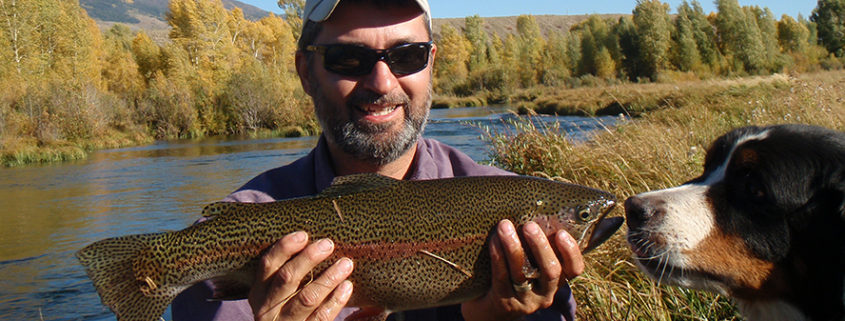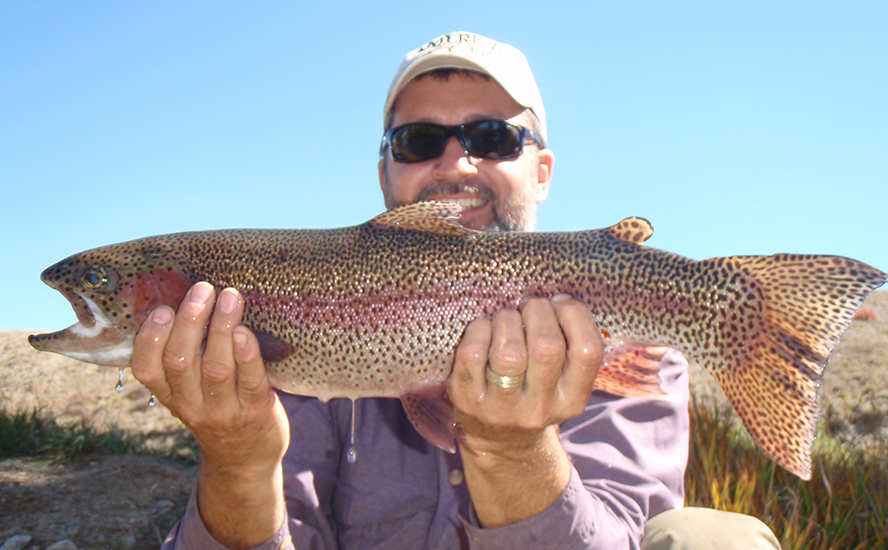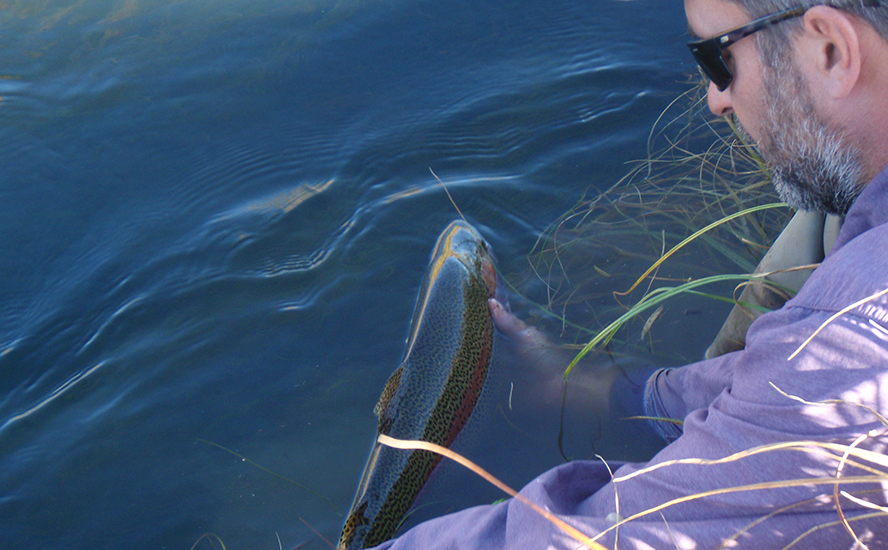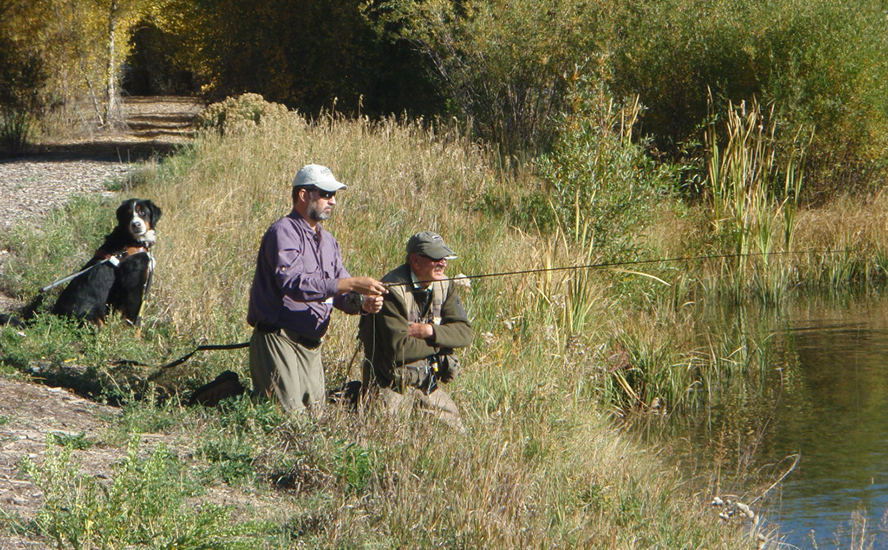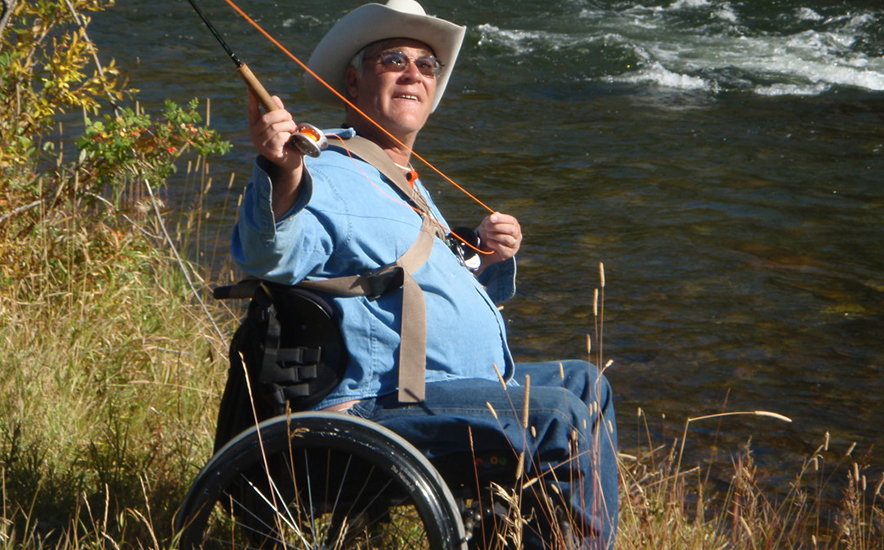Competing Blind in the America Cup International Fly Fishing Tournament
(First published in Bob Izumi’s Reel Fishing Magazine)
Few who know me would disagree that I enjoy fishing more than most. Having been registered blind at age eight and then living through a gradual and now complete loss of sight has done little to dampen my enthusiasm. In fact, some might say my enhanced sense of touch and ability to focus has even given me a slight advantage. But, am I capable of fly fishing? The question arose when my good friend Lance Glaser called with an invitation to compete in the America Cup International Fly Fishing Tournament.
Now some may think that asking a blind guy to fly fish is just plain cruel, and to then have him fish in front of 70 of the world’s top fly fishers is bordering on sadistic. In fact, these were just two of many insults hurled at Lance last summer by several of our fishing buddies when he strapped me into a stand-up harness and then stood back while the 15 lb Bonita I had on for bait was engulfed by an extremely large Bullhead shark. All this to say, my friendship with Lance goes back far enough for him to know I’m not one to turn down an offer to go fishing.
The America Cup International Fly Fishing Tournament is staged out of Frisco Colorado located at an altitude of 9,000 feet. Rivers Fished include sections of the Arkansas, Colorado and Blue. Competitors come from around the world, with the exception of my team, a hand-picked group of fishing enthusiasts with disabilities — of one sort or another. It was Lance’s hope that his “Rods and Wheels” team would demonstrate that people with disabilities could compete as equals in the world of fly fishing.
I was just a kid when the outdoor columnist for our home town’s weekly paper and local fishing “God,” Mr. George Hore, took me under his wing. My apprenticeship included being spellbound as George relayed details of how he caught or shot the various mounted fish, fowl and game that adorned his living room. It also involved many-an- hour in his basement tackle shop as he demonstrated the art of tying flies. My flies may have been crude and my casts less than precise, but I did become fairly adept at tying and fishing nymphs.
As my sight continued to decrease, I eventually turned to ultra-light spinning gear, a development I hid from my mentor George for fear of being labelled a heretic. Over time, I did find that I was picking up my fly rod less-and-less, and to be frank, when I got the call from Lance I wasn’t even sure where in the basement my fly rod now languished. In hind-sight, I may have stretched the truth somewhat when I said to Lance, “no problem, I love fly fishing”.
Lance suggested I come to Colorado several days prior to the Tournament to take in a few day’s of fishing together as he had a weekend commitment that was going to prevent him from competing himself. Upon reflection, I think maybe he harboured certain doubts about my fly fishing abilities, and didn’t want to be embarrassed for nominating me to the team.
The morning after arriving, Lance, me and my guide dog were driving through the now famous town of South Park located in Park County Colorado. We were heading for the Hartsel Ranch and 4-Mile Creek. Turned out Lance’s notion of a refresher course involved using dry flies on a creek so small the pools were the size of hot-tubs. Further complicating matters were strong winds descending from the surrounding mountains peeks, and trout that would disappear the instant a flicker of light touched the surface of a pool.
We decided to enter the river and fish pools well up-stream. Lance advised taking no more than one false cast to avoid spooking the Trout, a hard-wired reaction to flickering light Colorado’s Trout have developed to counter the numerous predatory birds. So here I was, about to fish a creek reminiscent of my childhood, only this time without being able to see a thing. I know my casting technique was sound having practiced with Bill Spicer from the New Fly Fisher at the Toronto Sportsman Show, but could I catch fish?
I shook out some line and made my first false cast straight into the wind. Lance suggested a little more line and a bit to the right. I discovered quickly enough that his directions were based on inches and not feet after settling my dry fly first on the right bank and then the left. By the time I managed to execute a few successful drifts, the Trout had long since cleared out. Between lance’s critiquing of my technique, the winds that were holding my slack line almost horizontal, and constantly having to remind my guide dog not to venture forward and spook the fish, a doubt began to creep into my subconscious that maybe I should admit to being an Isaac Walton impostor and simply withdraw from the competition.
Just for a lark I swapped my 5-weight rod for Lance’s 4-weight, and before long I was making 30+-foot precision casts. I also began getting hits, which brought up the next challenge, how was I to know when a Trout took my dry-fly? After catapulting several smaller Trout clear out of the river, we worked out an arrangement that when Lance said “Check”, I lifted my rod straight up in one fluid motion without changing the angle of the tip.
The next day’s practice session Lance stepped it up a bit with a wade up the Middle Fork River. A slightly larger river than what we had fished the day prior, but absolutely breathtaking in terms of offering up a true mountain fishing experience. With mountain peeks surrounding us on all sides, my senses were overwhelmed with Red Tailed Hawks screeching overhead, the sent of sweet Sage mixed with wild-flowers, temperatures that started the morning in the low 30’s and climbed 50 degrees to the mid 80’s by noon, cold fast running rivers, and large Brown, Rainbow, Brook and Cutthroat Trout that would leave one quaking in ones waders.
Lance and I took turns fishing the pools, but I still had a dry-fly tied on which, all things considered, isn’t my favourite. I didn’t know it yet, but a man I was going to meet that very evening would address my fly-selection concerns in ways that would later blow my mind.
Later that day I met my volunteer guide, Gene Gamber, CEO of the Breckenridge Adaptive Ski Program, and the rest of my team, Sarah Will (captain), Tred Barta, Carlos Thompson and Randy Ford. Each of us had a disability of one sort or another, but it fell on me to represent “fishing blind”.
Over dinner later that evening with Gene I was introduced to Billy Burger who was just coming off 25 straight days of guiding and was now kicking back for a bit of R-and-R. Now maybe Billy was just tired, or it may have been the “relaxing” Billy had par-took in already that evening, but he insisted I accept his offer to loan me several boxes of his home-made flies; the beauty of which rendered Gene speechless. I readily agreed.
Day one was tough on the Blue River without doubt. I started the day by breaking off on what had to be a 5lb Rainbow within moments of hooking up. I had been using a Hopper pattern as an indicator with a Wet fly and small Billy Burger nymph on the bottom. The Rainbow had taken the Nymph, a “Purple Poison” on a #18 hook, but for some reason my 4X leader parted the instant the Rainbow surfaced.
The water on the Blue River was moving unusually fast for the time of year with a flow rate of 800 CFS (cubic feet per second). The gates on the Green Mountain Reservoir up stream had been opened to meet demands for water in the Denver area 100 miles down stream and mountain due to a series of devastating fires that eventually destroyed over 100 Denver homes. The roiling water meant the Trout either hunkered down in deep pools or sought refuge by tucking far in under banks. It also didn’t help that tournament rules restricted us from fishing the far bank.
Gene and I worked around several islands in the centre of the river, leaving a good-sized pool close in to the bank for our team-mates who were restricted to bank fishing from their wheelchairs. The water was only just safe enough to wade, but would have swept away my guide dog, who instead stayed tethered to a shade tree in full view of the river.
Only one of our five-member team managed to land a fish on this section of the Blue River on day one. Over half the competitors fishing this stretch also blanked. Thankfully, the day two draw for beats had us far lower on the Blue where there were considerably larger and deeper pools.
Day two started with Gene and me crawling on hand and knee up to our first pool. My guide dog understood the drill and kept well back. It wasn’t long before we had our first fish of the tournament – a nice 21” Rainbow caught on a hopper pattern that I had dropped in under some over-hanging branches. This beauty was followed up in short order with a 23-inch Cut-Bow Trout, a naturally occurring hi-bred.
Most variations of the native Colorado Cut Throat Trout were almost eradicated due to the stocking practices of the government in the early 1900’s. Cut Throat Trout are not a particularly aggressive fish, and it was the government’s hope that the Rainbow would offer a more plentiful food source for local inhabitants, most of whom were minors. The fact that the faster more aggressive Rainbows would inter-breed with the native smaller Cut Throat was a development no one foresaw. Cut Throat are now being re-introduced and their habitat protected.
Mining practices begun in the mid 1850’s and which continue to this day also reeked havoc on native fish populations. Rivers were dredged for gold and other metals required to supply the military during various wars. Gravel river beds were excavated from depths of two feet down to as much as 100 feet. Mind tailings contaminated many local lakes, and the construction of roads and later reservoirs transformed the environment irreversibly.
With the emergence of Vail, Aspen and Breckenridge in the 1960’s as popular ski destinations, pressure from the tourism sector on local governments meant restrictions on mining operations for the first time. Tourism facility operators understood all to well that their customers wanted to ski in pristine wilderness settings, and not in industrial waste-lands. More recently, the volatile prices for beef cattle has led operators of large 25,000+ acre ranches to offer ecotourism experiences along with guided fishing and hunting adventures. Fields of grazing pasture are now being transitioned back to natural meadows and wet-lands, with millions of public and private dollars being spent on rehabilitating river banks.
Without doubt we had found ourselves on water heads-and-tails better than what we had fished on day one. Calmer, broader and deeper pools meant fish were able to feed more actively without fighting heavy current. These were river fish nevertheless, and their strength was truly extraordinary. It was nothing for a 2-foot Rainbow to peel out 90 feet of fly line and another 50 of backing.
More than once I experienced hooked Trout tearing past me and then just as suddenly turn and run in the complete opposite direction. The net result was a considerable loop of line being left far back in the Trout’s wake. The thrumming in my rod produced by the combined speed of the Trout and my effort to recover line is a sensation I’ll never forget.
Naturally, I lost my largest Trout after a short but intense fight. Within a split second of being hooked, Gene watched in awe as a 10lb-pluss Brown Trout darted directly towards us and then turn 180 degrees and cover 30 feet in a split second before breaking off. I knew I had a fish on and was scrambling to take in slack, and then suddenly the line went tight as a bow string and parted. Gene’s description of the Brown’s incredible speed left me profoundly shaken.
Our netting technique involved Gene crouching next to the river while I brought the fish in the last ten feet by reversing up the bank. Gene would then slip into the water and net the fish. I’d place the rod on the grass and slide in next to Gene to hold the net keeping the fish in the water as Gene extracted the fly. I’d then lift the Trout as Gene plucked my camera from my shirt pocket and snapped a quick photo, after which I would revive and release the fish. The Trout were out of water for no more than 30 seconds.
The Billy Burger nymphs and wet flies I was catching most of the Trout on were in the #18 to #22 size range. The 4-weight rod I used most of the time reduced my ability to force the fish, making for some intense stand-offs. The smallest of the 12 fish I caught throughout the tournament was an 18.5” Brown and the largest was a 25” Rainbow.
Day three was only a half-day of fishing, and we once again scored a decent section of the Blue River. My luck held and I managed to catch another five Trout. I worked a streamer on occasion to no avail, and took all my fish using the floating indicator fly with a wet fly and nymph suspended below. My 12-fish total was not enough to place me among the top anglers, but definitely positioned me in the top 50 percentile.
Many of the competitors coming from Europe used a technique called check nymphing. Instead of waders they used wet suits to almost fully submerge themselves leaving just their head and shoulders above water. Whether Check Nymphing actually constitutes fly fishing or is more akin to jig fishing is a debate I’ll leave for others to resolve. In fact, some might argue the method I was using involving floating indicators is little different than float fishing, thus, far be it from me to “throw the first stone”.
The Check Nymphing technique involves a long 11 to 13 foot rod with an extra-fast action. Instead of fly line, reels are loaded with 20lb mono tipped with 10’ fluoro leaders. There’s no actual fly casting involved as the flies are simply lobbed out. Fishers utilize wet suits to maintain a low profile in the water as they move about. Flies used are a combination of three weighted nymphs tied to the line 20” apart. The fisher selects weights that allow the current to tumble the offering along the bottom of the river bed. Heavy enough to provide bottom contact, but not too heavy as to hold fast.
The fisher simply lobs the offering up stream and then follows the presentation with the rod tip as it drifts and tumbles past. At the end of the drift the rig is extracted with a sharp jerk and flung back up stream for another pass. The extra light tip section of the rod allows the fisher to lift and check for bites without spooking the fish, and the heavier middle and lower section of the rod facilitates lightening hook sets. Check Nymphing is a highly effective method of catching neutral or highly pressured fish.
A lot of competitors caught some amazing fish throughout the 2.5 days, and the tournament went off without a hitch. I really enjoyed myself – I mean who wouldn’t have if they were in my shoes. I had a topnotch guide, an unlimited supply of amazing flies, access to the best gear and world class Trout Rivers. Did I make an impression on my fellow competitors – I think my team did very well on that front as well. It truly was a fishing adventure where all the “stars” were aligned to make for one amazing adventure, and many of these “stars” for me were the people I met along the way. One things for certain, I’m going to give the check nymphing technique a try as it seems to depend more on ones sense of touch than casting ability, and as exciting as dry-fly fishing might be to watch, unless the fish hooks itself, that’s one bite I almost never feel.
A big thanks to Lance Glaser for the invite, accommodations and two-days of pre-fishing instruction, to Gene Gamber of the Breckenridge Outdoor Education Center for the two days of excellent guiding and use of his very expensive rods, To Billy Burger for his killer flies, to our team manager Sherry Topping and her tireless work in organizing our participation, to the co-founders of the America Cup Dave Pehle and John Knight and their warm reception, and to my fellow team mates and the rest of the competitors for the great spirit everyone brought to the event.
Before heading back to Canada, I managed to spend a bit of time getting to know Tred Barta from the NBC TV show “The Best and Worst of Tred Barta”. He had brought along his infamous 150lb pull long bow, which I insisted on trying. I’m not bad with a bow – not that I’m precise in my shots, but more that I can cluster my shots quite tightly. Tred was impressed, and so was I with his tenacity to overcome his recently acquired cancer of the blood that left him paralyzed from the chest down. Strapped into a wheelchair, Tred was able to hook and quickly land 5lb Rainbows on a 1-weight fly rod.

